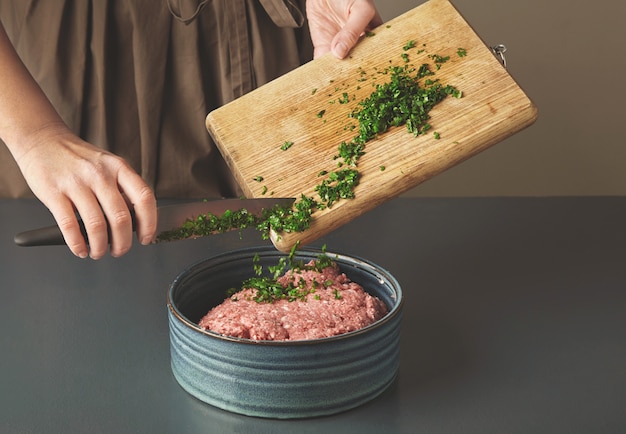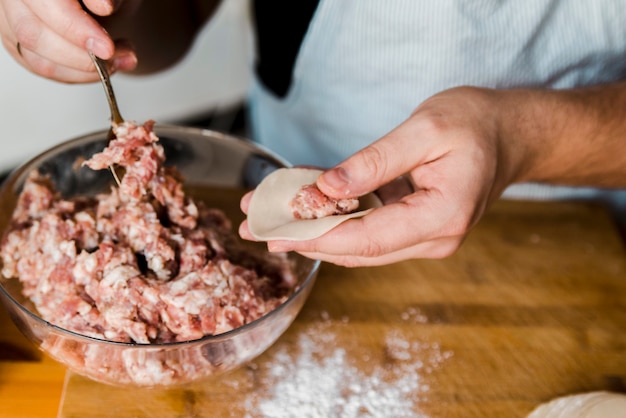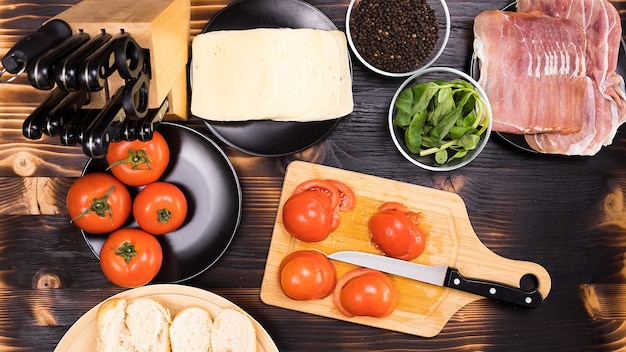Ham. It's a classic, a staple, but often relegated to the "boring" category. Not anymore, my friends! A perfectly cooked bone-in ham, with its rich, salty flavour and tender texture, is a culinary masterpiece. It's a dish that can transform your dinner table into a celebration of good food and good company.
This article is a journey through my personal experience with ham. We'll delve into the nuances of selecting the perfect ham, explore various cooking methods, and share some of the tips and tricks I've learned along the way. I promise, it's a journey you'll want to take!
(Part 1) Choosing the Right Ham: A Guide to Making the Best Choice

The first step in crafting a memorable ham experience is choosing the right one. It's not about grabbing the first ham you see. It's about finding the one that speaks to your culinary dreams.
A Ham for Every Occasion: Whole vs. Half
First, consider the size and occasion. A whole ham is a majestic beast, perfect for feeding a large crowd or hosting a holiday feast. It's a statement piece, a centerpiece that commands attention.
On the other hand, a half ham is a more manageable size, ideal for smaller gatherings or those who prefer a more intimate dining experience.
Fresh vs. Cured: Exploring the Flavour Spectrum
Now, the big decision: Fresh or cured? Both offer unique flavour profiles.
- fresh ham: Fresh hams are unprocessed, meaning they haven't been cured with salt. This gives them a more delicate, less salty flavour. Fresh hams require a longer cooking time and are best for those who prefer a subtle, clean taste. Think of fresh ham as a blank canvas for your culinary creativity, allowing you to experiment with glazes and flavour combinations to your heart's content.
- cured ham: Cured hams are already processed, soaked in a brine of salt and other seasonings. This gives them a more intense, salty flavour that many find irresistible. Cured hams often come pre-cooked, requiring only minimal reheating, making them a convenient choice for busy cooks.
Seeking the Perfect Ham: A Few Tips
Once you've decided on the type of ham, here are some tips for choosing the perfect one:
- Colour: Look for a ham with a light pink colour, a sign of freshness. Avoid hams with a grayish or purplish hue, as this indicates that the ham isn't at its peak.
- Texture: A good ham should feel firm and springy to the touch. Avoid any that feel mushy or slimy, as this could indicate spoilage.
- Smell: The ham should have a fresh, slightly sweet aroma. If it smells sour or ammonia-like, steer clear.
(Part 2) Preparing Your Ham: The Art of Trimming and Scoring

You've got your perfect ham. Now, it's time to prepare it for its star turn. This involves a little trimming and scoring, simple steps that enhance the ham's visual appeal and flavour.
Trimming for a Flawless Presentation
Trimming your ham is a bit like tidying up before guests arrive. It's about removing any excess fat and skin, resulting in a neater, more aesthetically pleasing final product.
Using a sharp knife, carefully cut away excess fat and skin, being mindful not to cut too deep. Leave a nice layer of fat, as this will provide flavour and moisture during cooking. If you're working with a whole ham, you may need to cut it into smaller pieces to make it easier to handle.
Scoring for Enhanced Flavour and Visual Appeal
Scoring the ham is an optional but highly recommended step. It's a simple technique that yields significant benefits.
Scoring involves making evenly spaced cuts across the fat layer of the ham, allowing the glaze to penetrate deeper and creating a beautiful visual effect. I typically use a sharp knife to make cuts about ?? inch apart and about ?? inch deep. You can get creative with your scoring patterns, but remember that deeper cuts can lead to a slightly drier ham.
(Part 3) Cooking Your Ham: Two Methods for a Delicious Result

Now, the moment of truth: Cooking your ham. Two classic methods reign supreme: roasting and smoking.
Oven-roasted ham: A Timeless Classic
Oven-roasting is a tried-and-true method that produces a consistently delicious, moist, and flavorful ham.
Instructions:
- Preheat your oven to 325 degrees Fahrenheit (160 degrees Celsius).
- Place the ham in a large roasting pan, fat side up.
- Pour about 1 cup of water into the bottom of the pan to create steam, preventing the ham from drying out.
- Cover the ham tightly with aluminum foil, ensuring even cooking and moisture retention.
- Roast the ham for about 15-20 minutes per pound.
- After the initial 15-20 minutes, remove the foil and generously baste the ham with your favourite glaze. I'm partial to a mix of brown sugar, honey, and mustard, but the possibilities are endless!
- Continue roasting, basting every 15-20 minutes, until the ham reaches an internal temperature of 145 degrees Fahrenheit (63 degrees Celsius).
- Allow the ham to rest for at least 15 minutes before carving and serving.
Tips for Oven-Roasted Ham:
- For a crispy finish, remove the foil during the last 30 minutes of cooking.
- Avoid overcooking the ham, as this can lead to dryness. Aim for an internal temperature of 145 degrees Fahrenheit (63 degrees Celsius).
- If you're using a fresh ham, you'll need to extend the cooking time. Consult the packaging for specific cooking instructions.
Smoking the Ham: A Journey into Smoky Flavour
Smoking your ham is a culinary adventure that yields a truly unique flavour profile. It requires a bit more time but promises a deeply satisfying, smoky flavour that elevates the ham to new heights.
Instructions:
- Prepare your smoker according to the manufacturer's instructions.
- Select wood chips that complement the ham's flavour. Hickory, apple, and pecan wood chips are excellent choices.
- Place the ham in the smoker, fat side up.
- Smoke the ham at a low temperature, around 225 degrees Fahrenheit (107 degrees Celsius), for 4-6 hours.
- Baste the ham with your favourite glaze every hour. A blend of maple syrup, brown sugar, and apple cider vinegar creates a delightful flavour combination.
- Remove the ham from the smoker when it reaches an internal temperature of 145 degrees Fahrenheit (63 degrees Celsius).
- Let the ham rest for at least 15 minutes before carving and serving.
Tips for smoking ham:
- Use a meat thermometer to accurately check the internal temperature of the ham.
- If the ham starts to dry out, add a pan of water to the smoker to create a humid environment.
- If you're using a fresh ham, you'll need to extend the smoking time. Refer to the packaging for specific instructions.
(Part 4) Glazing Your Ham: The Finishing Touch
Glazing is the art of adding a beautiful shine and a burst of flavour to your ham.
Glaze Choices: A Palette of Flavours
The beauty of glazing is that it's completely customizable. You can create your own unique glaze, or choose from a variety of classics:
- honey-mustard glaze: A delightful combination of sweet and tangy, pairing well with both fresh and cured hams.
- Brown Sugar-maple glaze: A rich and decadent glaze that adds a luscious caramelized flavour.
- Apple Cider Glaze: A slightly tart and fruity glaze that's perfect for a festive ham, bringing a touch of warmth and sweetness.
Glazing Techniques: Creating the Perfect Finish
There are various techniques to apply your chosen glaze:
- Basting: This involves brushing the glaze onto the ham while it's cooking. It's the most common method, allowing the glaze to penetrate the ham and create a beautiful glaze.
- Pouring: Pouring the glaze over the ham during the last 30-45 minutes of cooking creates a more intense glaze.
- Spooning: Spooning the glaze over the ham in the last 15-20 minutes creates a thinner glaze.
Tips for a Flawless Glaze:
- Don't glaze too early, as this can lead to burning.
- Use a pastry brush for even glaze distribution.
- If the glaze becomes too thick, add a splash of water to thin it out.
- pre-cooked hams don't require glazing, but it's always an option to enhance the flavour and presentation.
(Part 5) Serving Your Ham: The Grand Finale
The final step is serving your culinary masterpiece.
Carving the Ham: A Skill Worth Mastering
Carving the ham can seem intimidating, but it's actually quite straightforward.
- Use a sharp carving knife and a carving fork to hold the ham steady.
- Start by slicing the ham along the bone, then slice across the grain for tender, bite-sized pieces.
- If you're working with a whole ham, cut it into smaller pieces for easier carving.
- Don't forget to remove the bone before serving.
side dishes: The Perfect Accompaniments
Ham's versatility shines when it comes to side dishes. Here are some classic and crowd-pleasing choices:
- mashed potatoes: A timeless favourite that provides a comforting contrast to the ham's richness.
- green beans: A fresh and vibrant side dish that adds a burst of colour and flavour.
- Macaroni and Cheese: A cheesy and comforting side dish that's perfect for a family gathering.
- Asparagus: A light and elegant side dish that adds a touch of sophistication to the meal.
- fruit salad: A refreshing and sweet side dish that balances the savory flavours of the ham.
Serving Suggestions: From Casual to Formal
Ham is a versatile dish that can grace any table, from casual gatherings to grand celebrations. Here are some serving suggestions:
- Buffet Style: Serve the ham on a platter with a selection of side dishes. This is a great option for large gatherings where guests can mingle and choose their favourite combinations.
- Family Style: Place the ham in the centre of the table, surrounded by side dishes. This creates a more intimate dining experience, encouraging conversation and shared meals.
- Sandwich Style: Serve the ham on sandwiches with your favourite toppings. This is a fun and casual option, perfect for a quick lunch or a relaxed dinner.
(Part 6) leftover ham Ideas: Turning Leftovers into Culinary Delights
Leftover ham is a treasure trove of culinary possibilities. It's the perfect ingredient for a variety of delicious dishes.
Ham and bean soup: A Hearty and Satisfying Meal
Ham and bean soup is a comforting and satisfying way to use up leftover ham. The ham adds a depth of flavour to the soup, while the beans provide protein and texture.
Start by sautéing onions, carrots, and celery in a pot. Add the leftover ham, some broth, and your favourite beans. Simmer until the beans are tender.
ham and cheese quiche: A Savoury and Elegant Dish
Ham and cheese quiche is a delicious and elegant way to use up leftover ham. You can make your own crust from scratch, or use a store-bought crust for convenience. Fill the crust with eggs, cream, cheese, and leftover ham. Bake until the quiche is set.
Ham Salad Sandwiches: A Classic and Crowd-Pleasing Choice
Ham salad sandwiches are a classic and satisfying way to use up leftover ham. Chop the ham and mix it with mayonnaise, mustard, and chopped celery. Spread the ham salad on bread and add your favourite toppings.
Ham and Potato Hash: A Hearty and Savoury Breakfast
Ham and potato hash is a hearty and satisfying way to use up leftover ham and potatoes. Sauté the ham and potatoes with onions and peppers. Serve with a fried egg on top for an extra boost of flavour.
(Part 7) FAQs: Answering Your Ham-Related Questions
How long can I keep cooked ham in the fridge?
You can keep cooked ham in the fridge for up to 4 days. Wrap it tightly in plastic wrap or aluminum foil to prevent it from drying out.
Can I freeze leftover ham?
Yes, you can freeze leftover ham for up to 2 months. Wrap it tightly in plastic wrap or aluminum foil to prevent freezer burn. When you're ready to use it, thaw it in the fridge overnight.
What is the best way to reheat ham?
For the most even heating, reheat the ham in the oven at 325 degrees Fahrenheit (160 degrees Celsius) for about 15-20 minutes. You can also reheat it in the microwave or on the stovetop.
What are some other ways to cook ham?
You can also cook ham in a slow cooker, instant pot, or dutch oven. These methods are all great for achieving a tender and juicy ham.
How can I tell if ham is cooked through?
The best way to tell if ham is cooked through is to use a meat thermometer. The internal temperature should reach 145 degrees Fahrenheit (63 degrees Celsius) for cooked hams and 160 degrees Fahrenheit (71 degrees Celsius) for fresh hams.
(Part 8) Final Thoughts: Embrace the Ham-Making Journey
There you have it – a comprehensive guide to creating a truly amazing bone-in ham. Remember, the journey is as important as the destination. With a little practice, you'll be a ham-cooking pro in no time.
Don't be afraid to experiment with glazes and side dishes – let your taste buds be your guide. Most importantly, enjoy the process and the delicious results! Happy cooking!
Everyone is watching

How to Cook Frozen Lobster Tails Perfectly: A Step-by-Step Guide
RecipesLobster. Just the word conjures up images of lavish meals, special occasions, and a taste of luxury. But let's...

Pigs in a Blanket Cooking Time: How Long to Bake for Perfect Results
RecipesAh, pigs in a blanket. Just the name conjures up images of those delightful little parcels of crispy pastry en...

Pork Fillet Cooking Time: How Long to Cook It Perfectly
RecipesPork fillet, or tenderloin as it's sometimes called, is a real favourite in our house. It's so versatile, and...

The Ultimate Guide to Tender, Juicy Pulled Pork
RecipesRight, let's talk pulled pork. It's one of those dishes that just screams "comfort food," doesn't it? I mean...

The Ultimate Guide to Cooking Sweet Potatoes: From Roasting to Mashing
RecipesSweet potatoes. Just the name conjures up images of warm, comforting dishes, bursts of vibrant color, and a to...
